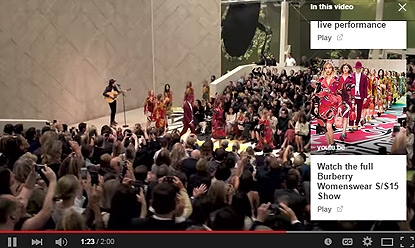YouTube Increases Interactivity In TrueView Video Ads
- by Laurie Sullivan @lauriesullivan, April 8, 2015

Google's YouTube has added interactive cards to its skippable TrueView video ads, giving marketers the option to include more information as overlays on video ad spots. It's another way to keep viewers' attention -- and more of the money in Google's coffer.
The TrueView advertising cards can contain information about the brand or its products, a list of pricing or related videos and playlists from the advertiser and, soon, links to the advertiser's Web site. It expands the canvas to pull up information about what people see in the videos.
The cards solve two challenges, according to Phil Farhi, director-product management for YouTube Ads. One is the way that ads work across screens. Many brands initially designed ads for a world in which people use a mouse. Adding mobile phones, tablets, connected TV, and gaming consoles with controllers required more of a template, he said.
With 95% of advertising running video ads across all screens, the cards aim to bring consistency to interactive video across platforms, but each needs to render it in a way that works best, Farhi said.
Burberry created a multi-layer video campaign where viewers of the 3:00 minute video used the TrueView cards to move from one part of the story to the next, unlocking Web, video and social content. Through Burberry's creative use of cards, fans could personalize a version of the show suited more to their interests. The video had five points within the video, each called out with specially created animations that draw the users to the expandable cards they could click on to reveal new layers of related content.
Burberry's video had an average view-through rate of 15%, and mobile click-through rate of more than six-times their desktop click-through rate, demonstrating a more engaged experience with the content on mobile.
YouTube also changed how it is charging advertisers for the TrueView ads, from when it launched five years ago. In the past, marketers paid if people watched their ad for a full 30 seconds. If an individual clicked to skip an ad after five seconds, the advertiser didn't pay for the view.
For pricing, advertisers with cards will be billed when someone clicks on a link in their video, whereas previously YouTube only billed when someone watched 30 seconds or the end of the video, whichever came first.


